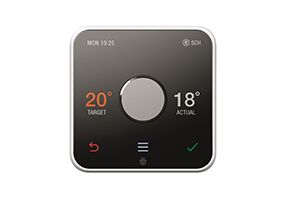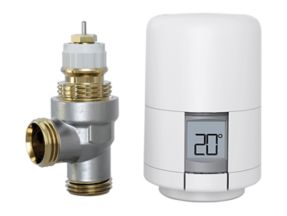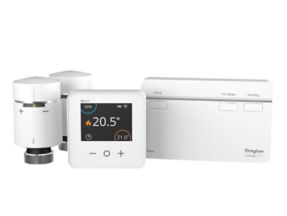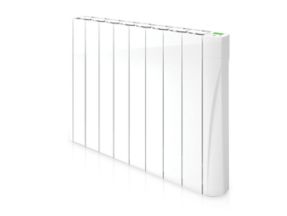SMART HEATING GUIDE
SMART HEATING GUIDE
Introduction
Smart heating systems are gaining in popularity as people look for a way to heat their homes more conveniently and efficiently.
If you’re thinking about installing smart home heating systems, this guide will tell you everything you need to know before buying. First, we cover what smart heating is, the types of smart heating systems available and how it all works. We’ll then look at smart thermostats, how they work, their cost, features, advantages, and disadvantages, and how to install them.

What is Smart Heating?
Smart heating is a home heating system that’s connected to the internet via Wi-Fi and controlled remotely through a smartphone, tablet, or PC. And the convenient thing about smart heating is that you don’t have to be at home to control it.
The most essential component of smart heating is the smart thermostat, as the system’s primary function is to adjust the heating temperature and switch it on and off. But smart home heating systems go beyond just that.
They come with all sorts of clever features, such as detecting open windows, turning the heating off if no one is home, turning it on when they’re about to return, and much more. We’ll cover these features in more detail later in this guide.
Other smart heating products include radiator valves, central heating control packs, and electric radiators. And there are many different brands available.
Types of Smart Heating System
Different types of smart heating products and accessories are available that make up a smart heating system. Some can be used independently, and others need to be used together.
Smart Room Thermostats
Smart room thermostats connect the central heating system to the internet so the heating can be controlled through smartphones, tablets, and PCs.
Some smart thermostats are wired, and some are wireless thermostats that can be used independently of any other smart heating products (look for thermostats that state that a smart hub isn’t required). They simply replace the current manual room thermostat and control the heating for the whole house.
Other smart thermostats are designed to be connected to other smart heating products (look for thermostats that state a smart hub is required). For example, when multiple thermostats are required to control the temperature independently in different rooms. These smart thermostats work alongside a smart central heating control pack (which includes the smart hub) and smart radiator valves.
Smart Radiator Valves
Smart radiator valves are devices that connect to plumbed in radiators to control their temperature output. They work in the same way as smart thermostats: connecting the radiator to the internet to control the temperature from a smart device. And they allow the temperature to be managed in each room independently.
Most smart radiator valves need to be connected to a smart hub, which can be purchased separately (e.g., the Hive Hub) or as part of a smart central heating control pack. But some also come with their own smart hub.
Smart Central Heating Control Packs
Smart central heating control packs are kits that connect the heating system with the internet. As a minimum, the pack consists of a smart hub (that connects to Wi-Fi and talks to all the other components in the system) and a smart thermostat. Some packs contain more than one thermostat, and some also include smart radiator valves.
A smart central heating control pack can be used to control the temperature in each room independently. Start with the control pack and buy additional smart thermostats and smart radiator valves depending on the number of rooms.
Several brands are available, and most smart central heating control packs are only compatible with their own brand of thermostats and radiator valves. So, always check compatibility before you buy.
Smart Electric Radiators
Smart heating controls aren’t just for plumbed heating systems. They are available for electric systems, too, in the form of smart electric radiators.
Smart electric radiators are radiators that connect to the internet so you can control heating from smartphones, tablets, and PCs. They work independently of any other smart heating system and allow the temperature to be managed in each room individually.
How Does Smart Heating Work?
Smart heating works by connecting a heating system with the internet so it can be controlled remotely using a smart device through Wi-Fi.
Smart heating components include:
- Smart room thermostats
- Smart central heating control packs
- Smart radiator valves
- Smart electric radiators.
Once smart heating components are installed, download an app (each smart heating manufacturer will have their own) and follow the instructions to connect it to the system.
Most can also be connected to a smart speaker, such as Alexa or Google Home, so the system can be voice-controlled. And, if you don’t have a smart device, some smart heating systems can connect to a website via a PC. Connectivity does vary for each brand, so always check before you buy.
Once the components and the app are set up, program the system via the app: when the heating needs to switch on and off and the temperature setting. These are the system's primary functions, much like a standard system. But a smart heating system allows more flexibility than that. The pre-set functions can be over-ridden, even when no one is home. Some smart heating systems can learn habits and adjust the heating accordingly, such as tracking movement, turning the heating off when nobody's in, and much more.
Smart heating controls can be connected to most types of heating systems as follows:
-
Just like a standard heating system, the boiler in a smart heating system is controlled by a thermostat. This means that smart heating works with most boilers, whether they run on gas, LPG or oil. There are some exceptions, though, so it's always best to check. Connecting the boiler to a smart heating system is often as simple as swapping the old manual thermostat for a smart thermostat.
If you’re upgrading the whole heating system and need advice on buying a new boiler, check out our boiler buying guide.
-
Solar thermal panels work by taking energy from the sun and transferring it into a hot water cylinder that heats the water up then pumps it around the radiators. The system is also connected to a boiler which kicks in when the energy from the sun isn't sufficient to heat the water enough. This system is controlled by a thermostat, which makes it compatible with smart heating systems as the old manual thermostat can simply be swapped for a smart thermostat.
Check out our guide to solar water heating for more information.
-
A heat pump is a unit that’s used to heat a home instead of a boiler. It extracts heat energy from outside, then brings it inside to provide heating. Heat pumps are controlled by a thermostat, which makes them compatible with smart heating systems. If a heat pump is already installed, the old manual thermostat can simply be swapped for a smart thermostat. Not all smart thermostats are compatible with heat pumps, though, so always check compatibility before you buy.
You can learn more about heat pumps in our guide: What is a heat pump and how does it work?
-
There are two types of underfloor heating: electric and warm water. As both types are controlled by a thermostat, they are both compatible with a smart heating system. If underfloor heating is already installed, the old manual thermostat can simply be swapped for a smart thermostat. Not all smart thermostats are compatible with underfloor heating, though, so always check compatibility before you buy.
Read our underfloor heating systems guide for more information.
As you can see, the main component of smart heating systems is the thermostat because it controls the temperature. So, let’s look at smart thermostats in more detail.
How Does a Smart Thermostat Work?
Smart thermostats connect to a boiler (or other heating systems) via the existing thermostat's wired connection. The smart thermostat then connects to the internet and communicates with an app on a smartphone, tablet or computer via Wi-Fi. The app works as a programmer to control heating remotely.
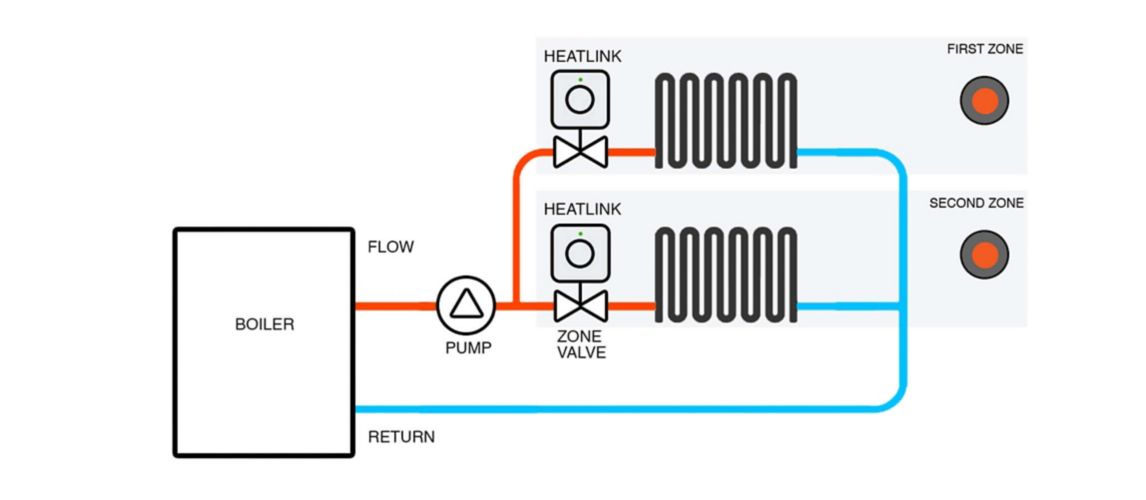
Smart Thermostat Features
The most basic feature of a smart thermostat is controlling when the heating is switched on and off and the temperature setting. But there are many other clever features available, depending on the model.
Other features of a smart thermostat include:
-
Multi-room and zones
This feature allows the temperature to be controlled in each room individually. Or you can set up heating zones – for example, you could have upstairs and downstairs as two different zones, so they can be heated independently. This feature is perfect for large homes because the heating can be turned off or down in rooms or zones that aren't being used, reducing energy bills. There needs to be a smart thermostat and smart radiator valve in each room or zone for this setup.
-
Smart learning
Some smart thermostats can program themselves by learning the household’s routine and habits, such as when people are home and the temperatures they like. The thermostat can also learn how a home heats up. It works by tracking heating use for a few days and then programming itself accordingly. And if the household doesn't like the settings it has chosen, they can be overridden in the app.
-
Smart motion sensors and GPS tracking
Some smart thermostats have built-in motion sensors to detect when a home or room is unoccupied. They turn the heating off or down accordingly, then turn it back on or up when it detects occupancy again. Some smart thermostats go one further than this with GPS tracking. The GPS tracking feature is usually called geolocation or geofencing. It allows the smart thermostat to track people in a household via their mobile phones. When no one is home, it can turn the heating off. And when it senses that someone is nearly home (based on a pre-set distance), it will turn the heating back on, so the house is warm when they arrive. This feature is ideal for people who are in and out of their homes at irregular times.
-
Weather responsive
Weather responsive smart thermostats check the weather using data from weather services and adjust their settings accordingly. For example, if a cold snap is forecast, the remote heating controls could turn the heating on earlier than usual or raise the temperature slightly. And, if it’s sunny outside, the thermostat will turn the temperature down by a few degrees, saving energy and money.
-
Hot water control
Some smart thermostats can control hot water as well as heating. This feature works with a hot water tank installed in the home. It isn't beneficial with a combi boiler since they supply hot water on demand anyway. This feature is useful when going away on holiday. The water can be turned back on remotely as the household returns home. Some smart thermostats have this function available, but the manufacturer charges an additional fee to use it.
-
Open window and draught detection
This feature can detect cold draughts in a room when the heating is on and notify the connected smart device. This means the window or draught can be dealt with, so heat isn't lost, and the room can then heat up to the correct temperature.
-
Energy reports
Some smart thermostats send a monthly energy report, showing energy use, such as how many hours the heating was used for, and comparing it month by month. This helps understand heating bills better. Some also suggest adjustments that can be made to help save energy and money.
-
Safety and holiday modes
Most smart thermostats have this feature. It monitors a home's temperature while the occupants are away on holiday and only turns the heating on if it drops below a safe limit. For example, to stop pipes freezing in a cold snap.
Smart Thermostats Costs to Consider
The cost of smart thermostats varies depending on the brand and their features. When working out the cost for a smart heating system, remember to factor in all the elements, including costs for:
- The smart thermostat (or multiple thermostats if you plan to set up multi-room or zones)
- A smart central heating control pack (great for multi-room/zones)
- Smart radiator valves
- Installation costs if you would rather use an installer than DIY
- Extra subscriptions to the manufacturer to use some features
Browse our range of smart thermostats to get the full insight into current costs and deals to best suit your needs.
Advantages of Smart Heating
Smart heating has many benefits:
-
Save energy and money
Smart thermostats allow greater control and flexibility of heating systems. They help save energy by, for example, turning the heating off when no one’s home. Turning down the heat in rooms not being used. And sending notifications when a window is open so it can be closed to stop heat escaping. All these energy-saving features also help to save money on heating bills. But, of course, the amount saved will depend on the features available on the thermostat chosen.
-
Integration with home tech
Smart heating connects to Wi-Fi, so the heating system becomes part of the smart home. It integrates with any smartphone or tablet through an app. And most can also be controlled through voice assistants, like Alexa and Google Home. They can even link smart heating to a calendar, so it knows when people are away from home.
-
Remote heating controls
With smart heating, you’re not tied to a control panel. Instead, you control heating remotely through a smart device, even when not at home. So, for convenience, heating can be turned off when no one’s home or turned on before they return.
-
Ease of use
Programming heating from an app is much simpler than programming a control panel, which typically means referring to a manual. In addition, apps are more intuitive to use and can be programmed from the comfort of a sofa as often as needed.
Disadvantages of Smart Heating
There aren’t many disadvantages to installing smart heating, but there are a few:
-
The hassle of installation
Swapping an old manual thermostat to a smart thermostat is a simple job a competent DIYer can do. But if you’re installing multiple thermostats and radiator valves, the installation becomes more complicated, requiring wiring in electrics and plumbing.
-
The benefits depend on occupancy
A smart heating system won’t make much difference if the home’s occupants aren’t there very much. And on the opposite end of the scale, it won’t make a difference if they are home most of the time.
-
Initial expense
The upfront cost of purchasing and installing smart home heating can be quite high. Particularly when setting up multi-room or zones. The cost of the thermostat alone is significantly greater than buying a standard thermostat.
-
Potential security problems
As with any internet connection point in a home, smart heating systems have the potential to be hacked. Therefore, internet security precautions should be taken, including choosing a secure password for the system.
How to Install a Smart Thermostat?
Installation of a smart thermostat can be a simple job if you're swapping an old thermostat for a new one. However, it becomes more complicated if multiple thermostats need to be wired into the system or smart radiator valves need to be installed. If that's the case, it may be a job best left to a professional installer.
Every smart thermostat will have its own set of installation instructions, but as a general guide, swapping an old thermostat for a new smart thermostat will involve some electrical rewiring, replacing the front and backplate of the existing thermostat, and detaching and reattaching wiring. Our top tip is to always ensure to turn the power off and take a photo of the old thermostat so you have a record of where the wires go.

